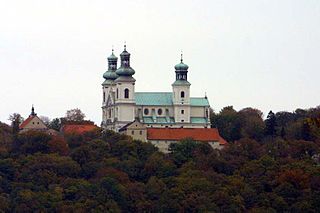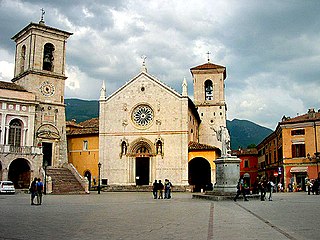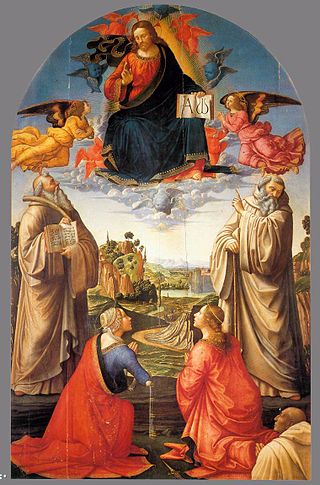
An abbey is a type of monastery used by members of a religious order under the governance of an abbot or abbess. Abbeys provide a complex of buildings and land for religious activities, work, and housing of Christian monks and nuns.

The Camaldolese Hermits of Mount Corona, commonly called Camaldolese, is a monastic order of Pontifical Right for men founded by Saint Romuald. Its name is derived from the Holy Hermitage of Camaldoli, high in the mountains of central Italy, near the city of Arezzo. Its members add the nominal letters E.C.M.C. after their names to indicate their membership in the congregation. Apart from the Roman Catholic monasteries, in recent times ecumenical Christian hermitages with a Camaldolese spirituality have arisen as well.

The Badìa Fiorentina is an abbey and church now home to the Monastic Communities of Jerusalem situated on the Via del Proconsolo in the centre of Florence, Italy. Dante supposedly grew up across the street in what is now called the 'Casa di Dante', rebuilt in 1910 as a museum to Dante. He would have heard the monks singing the Mass and the Offices here in Latin Gregorian chant, as he famously recounts in his Commedia: "Florence, within her ancient walls embraced, Whence nones and terce still ring to all the town, Abode aforetime, peaceful, temperate, chaste." In 1373, Boccaccio delivered his famous lectures on Dante's Divine Comedy in the subsidiary chapel of Santo Stefano, just next to the north entrance of the Badia's church.
A commendatory abbot is an ecclesiastic, or sometimes a layman, who holds an abbey in commendam, drawing its revenues but not exercising any authority over its inner monastic discipline. If a commendatory abbot is an ecclesiastic, however, he may have limited jurisdiction.

Subiaco is a comune (municipality) in the Metropolitan City of Rome Capital, in the Italian region of Latium, 40 kilometres (25 mi) from Tivoli alongside the River Aniene. It is a tourist and religious resort because of its sacred grotto, in the medieval St. Benedict's Abbey, and its Abbey of Santa Scolastica. It is one of I Borghi più belli d'Italia. The first books to be printed in Italy were produced here in the late 15th century.

Farfa Abbey is a territorial abbey in northern Lazio, central Italy. In the Middle Ages, it was one of the richest and most famous abbeys in Italy. It belongs to the Benedictine Order and is located about 60 km (37 mi) from Rome, in the comune (municipality) of Fara Sabina, of which it is also a frazione (hamlet).

Sansepolcro, formerly Borgo Santo Sepolcro, is a town and comune founded in the 11th century, located in the Italian Province of Arezzo in the eastern part of the region of Tuscany.

Casamari Abbey is a Cistercian abbey in the Province of Frosinone, Lazio, Italy, about 10 kilometers east-south-east of Veroli.

Tre Fontane Abbey, or the Abbey of Saints Vincent and Anastasius, is a Roman Catholic abbey in Rome, held by monks of the Cistercian Order of the Strict Observance, better known as Trappists. It is known for raising the lambs whose wool is used to weave the pallia of new metropolitan archbishops. The pope blesses the lambs on the feast of Saint Agnes on January 21. The wool is prepared, and he gives the pallia to the new archbishops on the Solemnity of Saints Peter and Paul, the Holy Apostles.

The Roman Catholic diocese of Sansepolcro was a Latin rite see in Tuscany, central Italy. It was erected in 1515, as the Diocese of (Borgo) Sansepolcro (Italian), though difficulties prevented the appointment of a bishop until 1520. On 30 September 1986, the diocese was suppressed and united with the Diocese of Arezzo and the Diocese of Cortona to form the Diocese of Arezzo-Cortona-Sansepolcro.

The Abbey of Saint Scholastica, also known as Subiaco Abbey, is located just outside the town of Subiaco in the Province of Rome, Region of Lazio, Italy; and is still an active Benedictine abbey, territorial abbey, first founded in the 6th century AD by Saint Benedict of Nursia. It was in one of the Subiaco caves that Benedict made his first hermitage. The monastery today gives its name to the Subiaco Congregation, a grouping of monasteries worldwide that makes up part of the Order of Saint Benedict.

The Abbey of St. Benedict on the Mountain, also known as Norcia Abbey, is a Benedictine community of monks located in southeastern Umbria, just outside the city of Norcia, Italy. Originally founded in the 10th century, the abbey was closed by the Napoleonic Army as part of its suppression of religious communities. A new monastic community was founded in 1998 by a group of American monks which was formally established the following year as a priory directly under the supervision of the Abbot Primate.

The Church of Santi Giusto e Clemente is a Roman Catholic church in Volterra, Pisa, region of Tuscany, Italy. It is also known as San Giusto or San Giusto Nuovo. For some 850 years, the church was affiliated to an adjacent Benedictine monastery, the Abbey of Sts. Justin and Clement, which is no longer extant.

Volterra Cathedral is a Roman Catholic cathedral in Volterra, Italy, dedicated to the Assumption of the Virgin Mary. It is the seat of the bishop of Volterra.
The Abbey of San Giusto is a former Cistercian monastery located in the valley of the river Marta approximately 4 km south of Tuscania, Province of Viterbo, Italy.

The Cathedral of Sansepolcro is a Catholic church in Sansepolcro, Tuscany, central Italy.

Morimondo Abbey is a former Cistercian monastery located at Morimondo, a few kilometers south of Abbiategrasso in the Metropolitan City of Milan, Lombardy, northern Italy. The surviving structure is Romanesque and Gothic. It was founded in 1134 as a daughter house of Morimond Abbey near Dijon, from which it took its name.

Praglia Abbey is a Benedictine monastery in the frazione of Bresseo in Teolo, Province of Padua, Italy. It is located at the foot of the Euganean Hills, some 12 kilometers southwest of Padua, and four kilometers from Abano Terme.

Christ in Glory with Four Saints and a Donor is a c.1492 tempera on panel painting by Domenico Ghirlandaio and his studio.

The Abbey of Leno, or Badia leonense, was an ancient Benedictine monastic complex founded in 758 by the Lombard king Desiderius in the territory of the present-day town of Leno, in the Lower Brescian region. Demolished at the behest of the Venetian Republic in 1783, today only stone fragments of the ancient abbey remain, largely preserved in the Brescian museum of Santa Giulia, while burial mounds were found on site as a result of archaeological excavations held in 2003 by the Superintendence for Archaeological Heritage of Lombardy.


















